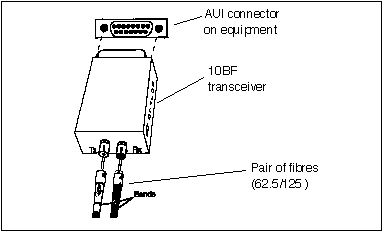
One form of cabling supported by Ethernet is fibre optic cable. This type of cable is expensive to purchase and difficult to install. Its primary use is to interconnect buildings and to connect equipment which is too remote for connection using other types of cabling (e.g. 10B5, 10B2, or 10BT). (It is also used by other networking systems than Ethernet, and may operate at much higher speeds). The official name for this cable is 10 BasebandF (10BF), indicating that it is specified for baseband communications (i.e. not modulated) at 10 Mbps using fibre optic cabling.
Fibre optic cable is usually installed by a specialist cabling contractor and “terminated” at a wall-mounted connector. A flexible fibre optic “patch” cable is used to connect a fibre optic Ethernet transceiver to the glass fibre optic cable. Fibre optic cable is much more expensive to purchase and install than copper cable. However, it has advantages:
• It is immune to electromagnetic interference
• It can span longer distances without attenuation
• It eliminates grounding problems
• It is secure from unauthorised taps
A 10BF link may only be made between two pieces of equipment (i.e. a point-to-point link), it is not a shared medium, as in 10B2 or 10B5 cabling systems. Normally the equipment which is to be connected are Ethernet repeaters of a bridge between two LANs.

Connection of transceiver on equipment to a 10BF Ethernet network
Two standards have been developed for fibre transceivers oeprating at 10 Mbps:
A summary of the properties of this type of cabling is given below:
* N.B. Maximum network diameter of the longest serial connections of segments in any single Ethernet collision domain must be less than 5km.
See also: